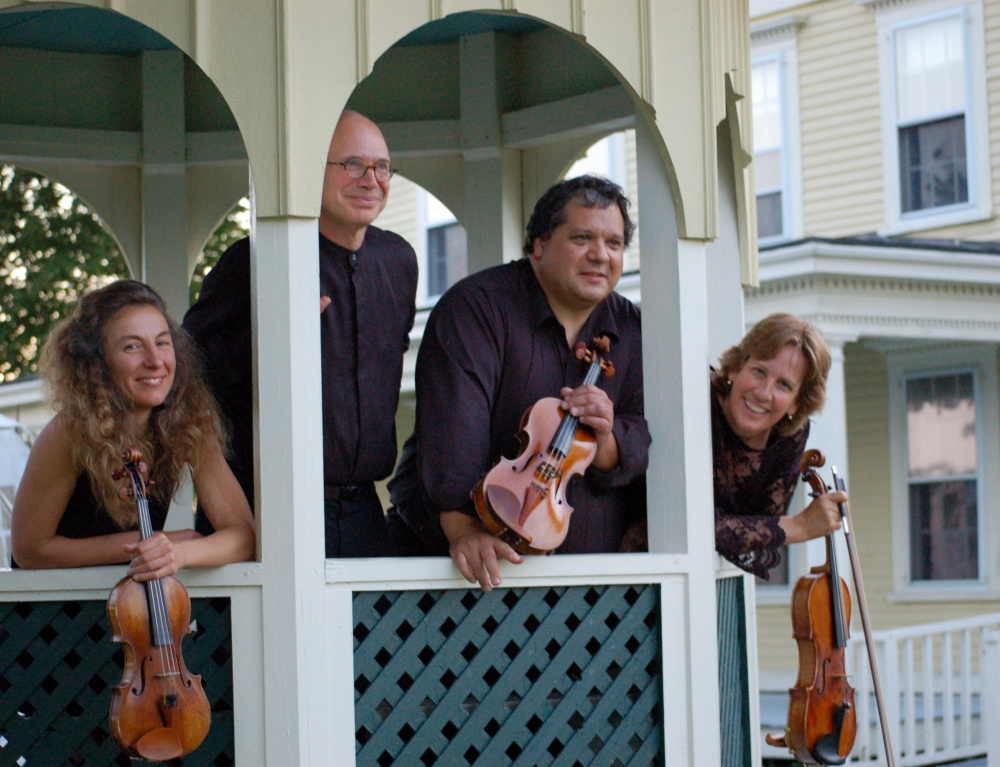Perhaps one reason the DaPonte String Quartet gives such consistently polished performances is that it seems disinclined to rest. Although its concert on Thursday evening concluded its first three-concert series at the Maine Jewish Museum, one of several venues it plays in southeastern Maine during the regular season, the group plans to spend much of June on a Down East tour and will play summer concerts along the coast in July, August and September. It has not published its schedule for next season, but if last year is an indication, it will tour outside the state in October before picking up its regular season in November.
For its finale at the museum, the group turned the reins over to Ferdinand Livia, a violinist, who compiled “Dino’s Hit List,” a program that brought together two works from the standard canon – Mozart’s String Quartet No. 22 in B-flat major (K. 589) and Beethoven’s String Quartet No. 8 in E minor (Op. 59, No. 2) – and one delectable rarity, Ottorino Respighi’s Quartetto Dorico (Op. 144).
Respighi, though a prolific composer, is known today for only a handful of works, mainly the picturesque Roman trilogy (“The Fountains of Rome,” “The Pines of Rome” and “Feste Romane”) and “Ancient Airs and Dances.” The Quartetto Dorico, or Quartet in the Dorian Mode, was composed in 1923, the same period as his orchestral showpieces, and it deserves to be heard more frequently than it is.
Its many charms begin with Respighi’s use of the Dorian mode – think of it as a scale starting on D, but using only the white notes (or, as a major scale with a flatted third and seventh) – which yields themes that can sound exotically ancient.
Respighi tapped that effect directly, opening the work with a unison theme that film buffs are likely to hear as packed with stock moves from the soundtracks of 1950s epics about medieval English knights. Respighi, writing in Italy, a quarter century before such films were made, had no such thing in mind, and after that initial burst of antiquity, he moves on quickly, giving his music a lustrous harmonic cloak.
Livia noted in his introductory comments that, from a player’s point of view, the individual parts are so dense that the score feels as though it were meant for chamber orchestra. He has a point; much of the piece has the same sumptuous, thick-textured quality you hear in Tchaikovsky’s and Dvorak’s string serenades, but couched in early 20th-century harmonies. Like his scores for large orchestra, it has painterly qualities – passages built on an interplay of light and dark, with dark hues taking over in the 20-minute score’s final moments.
The players gave the score a vigorous reading that, in the context of Livia’s other choices, said as much about the group’s flexibility as about the work itself. The group had opened the program with the Mozart, a late work (the composer’s penultimate quartet) that is the picture of democratic scoring, with each of the four instruments having a significant share of the spotlight.
Where, in the Respighi, the goal is a shimmering, full-ensemble sound, the Mozart thrives on textural transparency, with each line carefully sculpted and intricately balanced against the others. In the DaPonte performance, even accompanimental lines demanded attention. You almost felt as if you were missing something if you focused too fully on the main themes, as they traveled through the ensemble.
The Beethoven, which closed the concert, required yet another shift of aesthetic. This is pure drama – hefty, impassioned music, full of tension (and, only occasionally, resolution), with moments of otherworldly illumination within its stormy contours. The performance was energized and impeccable, as vital a season finale as you could want.
Allan Kozinn is a former music critic and culture writer for The New York Times who lives in Portland. He can be contacted at:
allankozinn@gmail.com
Twitter: Kozinn
Send questions/comments to the editors.


